
A beach is a landform alongside a body of water which consists of loose particles. The particles composing a beach are typically made from rock, such as sand, gravel, shingle, pebbles, etc., or biological sources, such as mollusc shells or coralline algae. Sediments settle in different densities and structures, depending on the local wave action and weather, creating different textures, colors and gradients or layers of material.
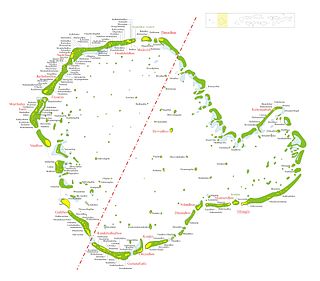
Huvadhu, Suvadive, Suvaidu or Suvadiva is the atoll with most islands in the world. The atoll is located in the Indian ocean. It is south of the Suvadiva Channel in the Republic of Maldives with a total area of 3152 km², of which 38.5 km² is dry land. The atoll contains 255 islands.

The Maldives are formed by 20 natural atolls, along with a few islands and isolated reefs today which form a pattern stretching from 7 degrees 10′ North to 0 degrees 45′ South. The largest of these atolls is Boduthiladhunmathi, while the atoll containing the most islands is Huvadhu.
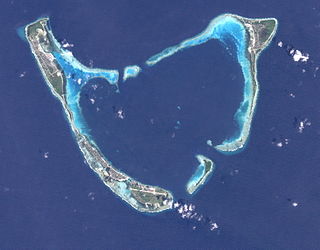
Addu Atoll, also known as Seenu Atoll, is the southernmost atoll of the Maldives. Addu Atoll, together with Fuvahmulah, located 40 km north of Addu Atoll, extend the Maldives into the Southern Hemisphere. Addu Atoll is located 540 km south of Malé, the country's capital. Administratively, Addu Atoll is the location of Addu City, one of the four cities of the Maldives. Addu City consists of the inhabited areas of Addu Atoll, namely the natural islands of Hulhudhoo, Meedhoo, Maradhoo, Feydhoo, and Hithadhoo.. In addition to the areas that are included as a part of Addu City, Addu Atoll has a number of other inhabited and uninhabited islands, including the island of Gan, where Gan International Airport is located.

Gnaviyani Atoll is one of the administrative divisions of the Maldives corresponding to the natural atoll, Fuvahmulah. Surfacewise this is the smallest administrative unit in the Maldives, situated in the Equatorial Channel between Huvadhu Atoll and Addu Atoll.

Fuvahmulah City is an island (atoll) in the Maldives. It is under Maldives administrative divisions of Gnaviyani Atoll or Nyaviyani Atoll. The inhabitants speak a distinctive form of the Dhivehi language, known as "Fuvahmulaki baha".

The culture of the Maldives is derived from a number of sources, the most important of which is its proximity to the shores of Sri Lanka and South India. The population is mainly Indo-Aryan from the anthropological point of view. The main religion followed here is Islam and only Muslims are considered as full citizens according to its constitution.
Montenegro is one of the fastest-growing tourist destinations. In 2007, over a million tourists visited Montenegro, making some 7.3 million overnight stays. This accounted for some 480 million euros in tourism revenue in 2007. In 2015, tourism realised over 1.7 million arrivals, with a further increase in 2016. In the same year, the coastal town of Kotor was named the best city to visit by Lonely Planet, whereas the country itself is continuously included in touristic top lists. With a total of 1.8 million visitors in 2016, the nation became the 36th most popular country to travel to in Europe. Montenegro was further visited by over 2 million tourists in 2017. The Government aims to attract greenfield investments, which should make best use of undeveloped parts of the coast, such as Jaz Beach, Velika Plaža, Ada Bojana and Buljarica.
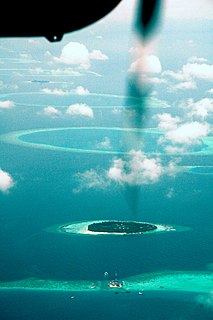
The wildlife of Maldives includes the flora and fauna of the islands, reefs, and the surrounding ocean.
Beach evolution occurs at the shoreline where sea, lake or river water is eroding the land. Beaches exist where sand accumulated from centuries-old, recurrent processes that erode rocky and sedimentary material into sand deposits. River deltas deposit silt from upriver, accreting at the river's outlet to extend lake or ocean shorelines. Catastrophic events such as tsunamis, hurricanes, and storm surges accelerate beach erosion.
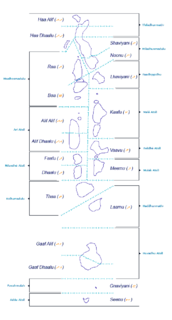
The Administrative Divisions of the Maldives refers to the various units of government that provide local government services in the Maldives. According to the Decentralization Act 2010, the administrative divisions of the Maldives would consist of atolls, islands, and cities; each administered by their own local council, under the basic terms of home rule. Geographically, the Maldives are formed by a number of natural atolls plus a few islands and isolated reefs which form a pattern from North to South. Administratively, there are currently 189 islands, 18 atolls and 4 cities in the Maldives.

Apo Reef is a coral reef system in the Philippines situated in the western waters of Occidental Mindoro province in the Mindoro Strait. Encompassing 34 square kilometres (13 sq mi), it is considered the world's second-largest contiguous coral reef system, and is the largest in the country. The reef and its surrounding waters are protected areas administered as the Apo Reef Natural Park (ARNP). It is one of the best known and most popular diving regions in the country, and is in the tentative list for UNESCO World Heritage Sites.
Dhadimagu is an administrative division of Fuvahmulah, Maldives. It is the largest division of the island, located on the north-west of the island. Throughout history, many scholars and famous public figures came into being from this district housing many of the historical sites and landmarks of the island. A center of learning as well as an important location for the island's economy, the number of 'Hafiz's and teachers from this district outnumber that of any other district in Fuvahmulah, and this district is considered by many to be the most educated and learning-centered district of Fuvahmulah.

Sand is a granular material composed of finely divided rock and mineral particles. Sand has various compositions but is defined by its grain size. Sand grains are smaller than gravel and coarser than silt. Sand can also refer to a textural class of soil or soil type; i.e., a soil containing more than 85 percent sand-sized particles by mass.
Funaadu is an administrative division of Fuvahmulah, Maldives. This is one of the largest wards in Fuvahmulah. The origin of its name lies in some large groves of the tree known locally as "Funa" that were located on its southern end.
Dhoondigan is an administrative division of Fuvahmulah, Maldives. It is the most populous district and the second largest by area. This ward lies in the Southeastern corner of the island sharing borders with Mālegan and Funaadu.

Haa Alif Atoll is the code name based on the letters of the Maldivian alphabet commonly used to refer to the administrative division officially known as North Thiladhunmathi Atoll in the Maldives.
Dhadimagi Kilhi is one of the two fresh water lakes in Fuvahmulah, Maldives.
Bandaara Kilhi is one of the two fresh water lakes in Fuvahmulah, Maldives.
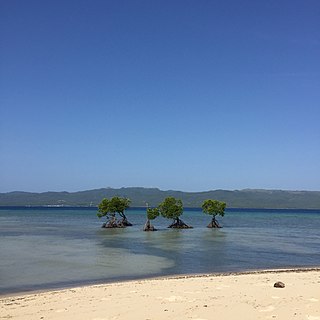
Alibijaban is a small island located off the southeastern coast of Bondoc Peninsula in the Philippines. It belongs administratively to the municipality of San Andres, Quezon province, and is coterminous with the barangay of the same name. With a population of 1,643 inhabitants in 2015, it is the smallest of seven barangays in San Andres.













